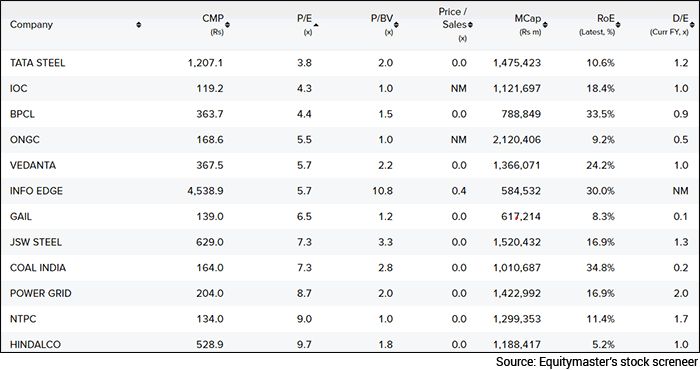- Home
- Views On News
- Feb 14, 2022 - Looking for Undervalued Stocks? Check Out these 4 Companies Trading at Attractive PE Ratios
Looking for Undervalued Stocks? Check Out these 4 Companies Trading at Attractive PE Ratios

If you aspire to make extraordinary wealth from the stock market, then you need to hunt for companies with strong growth prospects.
But that's not all, you need to buy these stocks at an attractive valuation, when they're trading below their intrinsic values.
Now that raises the question of how to know if the stock is undervalued or not. Well, investment professionals use a slew of ratios to determine this. One such ratio that every investor looks at is price to earnings (PE) ratio.
The PE ratio is defined as the ratio of a company's current share price per share divided by its earnings per share. It informs an investor about the price a buyer is willing to pay for a rupee of a company's earnings.
For example, a stock with a P/E ratio of 20 means you are paying 20 rupees for one rupee of earnings. The higher the P/E ratio, the more you are paying for a rupee of earnings, and the more expensive the stock.
By investing in a company which trades at a conservative PE multiple, you make sure you're not overpaying. Also, you won't lose too much if the market crashes.
Ben Graham, also known as the father of value investing, believed that a great company trading at a PE ratio of less than 20 is worth investing in.
With the help of Equitymaster's powerful stock screener, we bring you 4 stocks currently trading at a PE ratio of less than 20x.
The PE ratio is calculated on the basis of the company's trailing twelve month results. These are the stocks which came up when we ran the screener for low PE stocks in India.
#1 Hero Motocorp
Hero Motocorp is the largest manufacturer of 2 wheelers in the world. It is the undisputable market leader in India's 2-wheeler market with a market share of 34.5% as of December 2021.
Despite this, it is trading at a price to earnings (PE) multiple of 17 which is not too high.
The company has been experiencing weak demand since 2017. That is perhaps the reason behind its low PE ratio.
In 2017, the Indian government laid out the BS-6 emission standard as a measure to curb air pollution. In April 2020, the government made it mandatory for all auto manufacturers to sell only BS-6 compliant vehicles.
Consequently, auto manufacturers had to scrap all their inventory that didn't comply with BS-6 emission norms and absorb the losses. This move had a significant impact on the financials of all auto manufacturers.
Transitioning to BS-6 resulted in higher manufacturing costs. This increased the costs for consumers. As retail prices surged, automakers experienced a slump in demand. On top of that, pandemic led lockdowns exacerbated the situation.
Amid all the dark clouds hovering above the Indian auto industry, electric vehicles (EVs) appear as a silver lining. EVs, being zero emission vehicles, eliminate the need for complying with emission norms.
Hero MotoCorp is betting big on India's EV revolution by investing across the supply chain.
The company manufactures and markets a range of electric 2-wheelers under the Hero brand. For the six months ended July 2021, it sold 15,000 electric scooters, highest among the Indian manufacturers. Going forward, the company will double its EV production capacity to 5 lakh units/annum.
On the EV infra side, the company is betting big on battery swapping technology. It aims to build a network of battery swapping stations across the country. To achieve the same, the company has forged a strategic partnership with Taiwan based Gogoro technologies, a pioneer in battery swapping.
Talking of other investments in the EV space, Hero has invested in Ather and Blusmart. These are among the fastest growing companies in the Indian EV space.
While Ather is the leading manufacturer of electric 2-wheelers, Blusmart is the first and the only ride hailing company that operates a fully electric fleet.
If Hero's EV bets turn in its favour you would witness one of the greatest financial turnarounds in India's stock market history.
To know more, check out Hero MotoCorp' financial factsheet and quarterly results.
#2 State Bank of India (SBI)
SBI is the oldest and the largest commercial bank in India. It is a public sector bank (PSB) with a market share of 23% by assets.
SBI is currently trading at a PE multiple of 14x which is low compared to the industry's average of 23.5x.
So, why is India's largest bank trading at such a low PE ratio?
SBI might be the largest lender in India but not the most efficient one. For very long, the bank has struggled with the bad debt problem.
In cases where borrowers fail to honour their debt obligations, a bank needs to compensate for the loss by setting aside a portion of its revenue. This portion appears as provisions on a bank's P&L statement.
SBI has had a history of reporting higher provision every passing year. Higher provisions eat up a major chunk of the bank's revenue leaving no or little money for investors.
However, India's largest commercial bank is up for a major turnaround. Many investors and financial institutions are extremely bullish about the bank's future growth.
There are a few reasons behind investors' firm confidence in the bank's future financial performance.
The most important is the incorporation of a national asset reconstruction company limited (NARCL). NARCL is a government entity that will buy the bad loans from the Indian banks thereby helping them clean their books.
The interest cycle in India is at its lowest, flooding the Indian economy with cheap credit. This cheap credit will help drive India's economic growth. Therefore, Indian banks will report strong credit growth in the near future.
SBI being the largest lender is seen as the largest beneficiary of India's economic growth. For all the reasons discussed above, SBI certainly deserves a place on your watchlist.
To know more, check out SBI's financial factsheet and quarterly results.
#3 Indian Oil Corporation (IOCL)
IOCL is India's largest oil refinery company accounting for one third of the country's refining capacity.
The company is present across the entire hydrocarbon value chain. That means apart from refining it manufactures and sells value added products such as lubricants and engine oil. It is the largest government owned oil corporation in the country and the most profitable too.
IOCL currently trades at a PE multiple of 4.4x which is fair if compared with the industry average.
However, it is still low primarily because it is a highly risky business. There's always a risk of some refinery catching on fire which would in turn impact the production capacity and subsequently the company's financials. Also, IOCL hasn't grown much in the last few years.
What makes IOCL a good bet is its diversification efforts. It is exploring other non-hydrocarbon opportunities which could help it grow steadily.
IOCL has one of the largest networks of petrol pumps in India. The company is installing EV charging stations and battery swapping stations across its network.
It has entered into a joint venture with Phinergy, a clean energy company based out of Israel. IOCL aims to leverage this JV to develop aluminium air batteries, an alternative of lithium ion batteries. IOCL has already onboarded top Indian automakers such as Maruti Suzuki and Ashok Leyland to deploy this battery technology commercially.
IOCL has bought a stake of 4.9% in Indian Gas Exchange (IGX), subsidiary of IEX and India's first electronic platform for trading gas and allied products.
Apart from these, the company is investing Rs 285 bn to expand its capacity. For these very reasons, IOCL seems to be a lucrative buy at this price point and could turn out to be a major wealth creator in the coming years.
To know more, check out IOC's financial factsheet and quarterly results.
#4 Bharat Electronics
Bharat Electronics or BEL is one of the prominent players in India's defence sector. It is a government owned for-profit company that manufactures advanced electronic products for the Indian military forces.
BEL is currently trading at a PE multiple of 19x despite having robust financials. But why?
Well, if you check the financial fact sheet of Bharat Electronics you would notice its high debtor days. BEL's debtor days stand at around 1,700 days. This means that it takes an average of 1,700 days for BEL to receive cash after making a sale.
BEL's high debtor days could be attributed to large turnaround time in the defence projects especially when developing complex products.
BEL is planning to bring its debtor days down by tapping sectors that have short turnaround time. It aims to leverage its expertise in electronics to tap opportunities in the non-defence sectors such as smart cities, smart meters, medical electronics, etc.
The company's efforts are clearly visible in its financial performance in 2021. For the same financial year, revenue from non-defence contributed 22% to its total revenue compared to 18% reported in the previous year.
The company has given a revenue guidance of 12-15% for the next few years. On top of that, it doesn't have any debt on its books.
So, BEL certainly deserves a place on your watchlist.
Snapshot of low PE stocks in India from Equitymaster's stock screener
Here's a quick overview of these companies based on some crucial financials.

Please note these parameters can be changed according to your selection criteria.
This will help you in identifying and eliminating stocks that are not meeting your requirements and give emphasis on those stocks that are well inside the metrics.
Should you invest in companies solely by looking at their PE ratio?
The simple answer is no. You should not invest in a company just because it is trading at a lower PE.
PE ratio doesn't tell you anything about the fundamentals of the company. So, the PE ratio viewed in isolation is not a credible factor.
An investor should dig deep to gauge the quality of a company's fundamentals. If a company trades at a price well below its true value, only then does it make a sound investment opportunity.
An investor would come across such investment opportunities if the company is not popular or when the market crashes.
If you find low PE stocks in these situations, don't be overjoyed. There may be more than meets the eye.
They may turn out to be value traps for you, dear reader. Value traps are stocks that are trading at very cheap valuations and never really recover in terms of stock price performance.
Instead, look for value buys with strong fundamentals and capable management. They have sustainable moats to help them weather good times as well as bad.
Happy Investing!
Disclaimer: This article is for information purposes only. It is not a stock recommendation and should not be treated as such. Learn more about our recommendation services here...
Equitymaster requests your view! Post a comment on "Looking for Undervalued Stocks? Check Out these 4 Companies Trading at Attractive PE Ratios". Click here!
1 Responses to "Looking for Undervalued Stocks? Check Out these 4 Companies Trading at Attractive PE Ratios"


SABBISETTI RAMACHANDRARAO
Jul 6, 2022WISH TO KNOW MORE